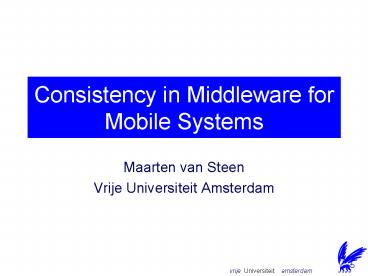Consistency in Middleware for Mobile Systems PowerPoint PPT Presentation
1 / 11
Title: Consistency in Middleware for Mobile Systems
1
Consistency in Middleware for Mobile Systems
- Maarten van Steen
- Vrije Universiteit Amsterdam
2
Why consistency is important (1/2)
- Observations
- Worldwide systems introduce scalability problems
that demand caching, replication, and
distribution of data (and possibly also
computations) - Having multiple copies introduces a
synchronization problem when it comes to updates - Synchronization in a wide-area system is
inherently expensive - Distribution of data may introduce a geographical
scalability problem data and its users may be
far apart if no special measures are taken (lack
of locality).
3
Why consistency is important (2/2)
- Solutions
- No general ones just make sure that your copies
are consistent enough for the application you are
dealing with. - Consistency models from DSM systems (Munin,
Treadmarks) - Client-centric consistency models (Bayou)
- Consistency and mobility
- Matters get worse because it may be difficult to
find out where data is needed next - A mobile user may pop up everywhere after having
been offline for some time (or disconnected mode) - Ad hoc groups of users
4
Support for consistency models
- Many consistency models have been developed. Im
not quite sure how many more we need or will show
up probably more than we can now think of - Since CDNs, some more attention is being paid to
the placement of copies across large networks
taking usage patterns into account - Less attention has been paid to the range of
possibilities for implementing models - Separate mechanisms from policies
5
Trade-offs for implementing consistency protocols
- How are changes distributed
- notification
- full state
- state differences
- operation
- How quickly does a copy react to inconsistency
- immediate
- lazy
- passive
- What does a nonpassive copy do with updates
- push to others
- pull from others
- How many concurrent updates are to be supported
- single
- multiple
6
Does differentiation make a difference?
- Experiment
- Monitored accesses and updates for our VU CS
Website - For each request
- from which autonomous system did it come from?
- what was the latency to the client's AS?
- what was the bandwidth to the client's AS?
- Did what if analysis experiments
- what if document D had been replicated to AS X?
- what if AS Y had installed a proxy server for
document D? - what if document D was always kept at its home
server? - .
7
Differentiation makes a difference!
8
What do we need for mobility?
- Observation
- we just picked some caching and replication
strategies - there may be many more that could be relevant
- we had a simple, relatively boring Web site
- Mobility
- we're talking about communication between
possibly moving parties this makes matters only
worse - we're also talking about communication between
parties that need not be online simultaneously. - We need mechanisms to support many different
message-distribution strategies
9
Rich set of mechanisms introduces problems
- Observation
- successful commercial applications do not
separate mechanisms from policies it's just too
difficult for application developers and users to
understand - Conclusion from Munin DSM too many alternatives
- Bayou had similar problems for selling their
model - Conclusion
- separation is OK, but you need to derive
strategies/policies automagically - We need self-adapting middleware solutions to
handle the variety of consistency models
10
Self-adaptation is a tough problem
- Back to the example
- we collected partial traces to predict changes in
distribution strategies and did runtime (i.e.,
in-the-loop) what-if analyses - evaluating a total of 10 different strategies,
analyzing 100 documents using a 500-request trace
took 140 ms on a 600 MHz PIII.
Potential scalability problem
running system
requests
traces
what-if analysis
strategy adaptations
11
Some conclusions
- Consistency models are needed to achieve
acceptable performance, and there will be quite a
few of them - Middleware has to offer simple mechanisms for
supporting a myriad of models - We need efficient feedback control loops for
self-adaptation of model parameters applications
and users can't handle this stuff

